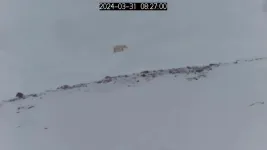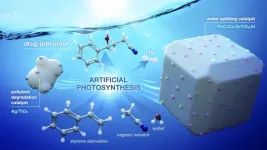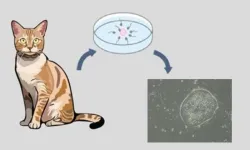(Press-News.org) CABI has led a team of scientists who have used DNA barcodes to narrow down the possible sources of introductions of an invasive banana skipper butterfly, with implications as to the threat of it spreading to Africa and tropical America.
The banana skipper, Erionota torus Evans (Lepidoptera, Hesperiidae, Hesperiinae, Erionotini) is a South-east Asian pest of banana that, in the last 60 years, has spread to the southern Philippines, Taiwan, Japan, India, Sri Lanka, Mauritius and La Réunion.
The new research, published in the journal CABI Agriculture and Bioscience, analysed a partial library of DNA barcodes from the indigenous and introduced ranges and suggests that aircraft are likely a pathway into new areas.
Gravid females may be attracted to airport lights
It is believed that gravid females may be attracted to airport lights while aircraft are being loaded at night and settling within aircraft before departure.
Indeed, it has been suggested that at least one of three separate invasions in Japan, all in the Ryukyu Islands of Okinawa and Kagoshima Prefectures, southern Japan, was unwittingly made on US military planes moving between the South Vietnam and the US Okinawa airbase during the Vietnam war.
The scientists found that based on their DNA barcodes indigenous populations can be divided into an ‘East’ group, in China and Vietnam, and a ‘West’ group in India, Nepal, Myanmar and west Malaysia.
Furthermore, within the ‘West’ group, there is a coherent ‘Malaysia’ subgroup from west Malaysia. Introduced populations in south India, La Réunion and Taiwan showed almost no variation in barcodes, suggesting they are each based on a single homogenous introduction.
They conclude that the introduced populations in Taiwan and Japan match the ‘East’ group, the introduced populations in Mauritius and La Réunion match the ‘Malaysia’ subgroup and the introduced population in south India matches the ‘West’ group.
Useful insight regarding the origin and potential pathways
Dr Matthew Cock, lead author of the research and CABI Emeritus Fellow, said, “Our study has added useful insight regarding the origin and potential pathways of introductions of E. torus in Asia and the Indian Ocean.
“We would have achieved more if larger numbers of samples and a wider geographical range of DNA barcodes had been available. Accordingly, this is a tool well worth including in future studies on introductions and pathways of alien invasive species.”
He added that the low level of replication and a limited library of barcodes from indigenous populations means that it can only be concluded with confidence that the introduced populations of E. torus in Taiwan and Japan match the ‘East’ group, the introduced populations in Mauritius and La Réunion match the ‘Malaysia’ subgroup and the introduced population in southern India matches the ‘West’ group.
The scientists say the results support earlier suggestions that the introduction to Mauritius was from west Malaysia, quite possibly on military aircraft, and the introduction to La Réunion was from Mauritius (or possibly west Malaysia).
They believe the introduction to southern India was either from north-eastern India or perhaps one of the adjacent countries, the introduction to Taiwan was from Vietnam or China (e.g. Hong Kong), the introduction to Okinawa was from Vietnam (as previously suggested) or China.
However, they say the introduction to Yonaguni Island, Japan, was from Taiwan. They were unable to obtain DNA barcodes from Sri Lanka or the Philippines to assess the likely origins of these introductions, but when DNA barcodes become available from these countries it will be easy to compare them with the barcodes reported here.
Full paper reference
Matthew J.W. Cock, Alan G. Buddie, Giovanni Cafa, Hideyuki Chiba, Athulya Girish Kizhakke, Yu-Feng Hsu and Krushnamegh Kunte, ‘DNA barcodes narrow down the possible sources of introductions of an invasive banana skipper, Erionota torus Evans (Lepidoptera, Hesperiidae)’. CABI Agriculture and Bioscience, 27 February (2025). DOI: 10.1079/ab.2025.0016
The paper can be read in full here: https://www.cabidigitallibrary.org/doi/10.1079/ab.2025.0016
CABI Agriculture and Bioscience
CABI Agriculture and Bioscience is an open access journal publishing high-quality, rigorously peer-reviewed multi-, inter- and transdisciplinary research focused on agriculture, food security, and the environment.
Global agriculture faces many challenges today. How can we produce more safe, nutritious food in the face of climate change? Can we balance greater efficiencies with the need to reduce greenhouse gas emissions and protect biodiversity? Can we meet changing market demands and yet develop more equitable economies? Can agriculture provide a livelihood and opportunities for women and young people?
These problems require increasingly complex and urgent solutions from researchers and policymakers. The journal editors are committed to encouraging an inclusive culture of scientific discussion and rapid information sharing among researchers worldwide.
END
DNA barcodes narrow down possible sources of introductions of an invasive banana skipper butterfly pest
CABI has led a team of scientists who have used DNA barcodes to narrow down the possible sources of introductions of an invasive banana skipper butterfly, with implications as to the threat of it spreading to Africa and tropical America.
2025-02-27
ELSE PRESS RELEASES FROM THIS DATE:
Transforming clinical care for children with rare genetic diseases
2025-02-27
Global partnerships that embed scientific research into clinical care are revolutionising the diagnosis and treatments for children with rare genetic diseases, according to a new report.
The white paper found despite advances in genomic technologies, which can detect rare genetic diseases within days, there remained significant challenges to ensuring this leads to improved child health outcomes. But global collaborations, such as the International Precision Child Health Partnership (IPCHiP), using evidence-based approaches to inform decisions in real-time, are overhauling patient care.
The paper was led by Murdoch Children’s Research Institute (MCRI), The Hospital for Sick ...
Polar bear cubs emerging from their dens for the first time: New study captures rare footage
2025-02-27
Svalbard, Norway – February 27, 2025 – Researchers from Polar Bears International, San Diego Zoo Wildlife Alliance, the Norwegian Polar Institute, and the University of Toronto Scarborough reveal the first detailed look at polar bear cubs emerging from their dens, captured through nearly a decade of remote camera footage in Svalbard, Norway. This research, published today on International Polar Bear Day in the Journal of Wildlife Management, marks the first combination of satellite tracking collars with remote camera traps to answer ...
Turning waste organic compound into useful pharmaceuticals and energy using a technique inspired by photosynthesis
2025-02-27
A research team led by Assistant Professor Shogo Mori and Professor Susumu Saito at Nagoya University has developed a groundbreaking method of artificial photosynthesis that uses sunlight and water to produce energy and valuable organic compounds, including pharmaceutical materials, from waste organic compounds. This achievement represents a significant step toward sustainable energy and chemical production. The findings were published in Nature Communications.
“Artificial photosynthesis involves chemical reactions ...
Violence alters human genes for generations, researchers discover
2025-02-27
In 1982, the Syrian government besieged the city of Hama, killing tens of thousands of its own citizens in sectarian violence. Four decades later, rebels used the memory of the massacre to help inspire the toppling of the Assad family that had overseen the operation.
But there is another lasting effect of the attack, hidden deep in the genes of Syrian families. The grandchildren of women who were pregnant during the siege — grandchildren who never experienced such violence themselves — nonetheless bear marks of it in their genomes. ...
Scientists discover key protein in resilience to stress
2025-02-27
When faced with chronic stress, why do some people develop anxiety and depressive symptoms while others show resilience? A protein that acts as a cannabinoid receptor and is present in the structure controlling exchanges between the bloodstream and the brain could be part of the answer, according to a study published today in Nature Neuroscience.
“The protein, called cannabinoid receptor type 1 (CB1), is part of the blood-brain barrier, the dynamic structure that protects the brain by regulating the passage of molecules between the bloodstream and ...
Nasal spray shows preclinical promise for treating traumatic brain injury
2025-02-27
A new study led by researchers at Mass General Brigham suggests a nasal spray developed to target neuroinflammation could one day be an effective treatment for traumatic brain injury (TBI). By studying the effects of the nasal anti-CD3 in a mouse model of TBI, researchers found the spray could reduce damage to the central nervous system and behavioral deficits, suggesting a potential therapeutic approach for TBI and other acute forms of brain injury. The results are published in Nature Neuroscience.
“Traumatic brain injury is a leading cause of death and disability — including cognitive decline ...
Cambridge initiative to address risks of future engineered pandemics
2025-02-27
Covid-19 showed us how vulnerable the world is to pandemics – but what if the next pandemic were somehow engineered? How would the world respond – and could we stop it happening in the first place?
These are some of the questions being addressed by a new initiative launched today at the University of Cambridge, which seeks to address the urgent challenge of managing the risks of future engineered pandemics.
The Engineered Pandemics Risk Management Programme aims to understand the social and biological factors that might drive an engineered pandemic and to make a major contribution ...
Unmasking inequalities in AI: new research reveals how artificial intelligence might reinforce inequality
2025-02-27
The researchers challenge the widespread belief that AI-induced bias is a technical flaw, arguing instead AI is deeply influenced by societal power dynamics. It learns from historical data shaped by human biases ,absorbing and perpetuating discrimination in the process. This means that, rather than creating inequality, AI reproduces and reinforces it.
“Our study highlights real-world examples where AI has reinforced existing biases.” Prof. Bircan says. “One striking case is Amazon’s AI-driven hiring tool, which was found to favor male candidates, ultimately reinforcing gender disparities in the job market. Similarly, government AI fraud detection ...
Taking sports science in her stride: How Dr. Nerea Casal García aims to maximize performance on the track
2025-02-27
The following is a Q&A with Dr Nerea Casal García, a sports scientist focusing on sports training and performance optimization. To speak to the author, or to receive an advance copy of the paper, please write to: press@frontiersin.org The paper will be published on 27 Feb 2025 06:15 CET]
Dr Nerea Casal García is an athlete, personal coach, and injury readaptation specialist who last year completed a PhD on observational analysis in elite sports. Today, she is a professor at the Institut Nacional ...
Pioneering work generates feline embryonic stem cells in boon for cats
2025-02-27
As different as they may seem, humans and cats have similar ailments, but in terms of health care, veterinary regenerative medicine is not as advanced.
A possible solution rests in embryonic stem cells, which can differentiate into various types of cells and be transplanted to restore internal damage. Further, they are characterized by their near-natural state similar to induced pluripotent stem (iPS) cells. Recent research has successfully generated feline iPS cells, but not embryonic stem cells, so research on these cell lines is essential to improve the quality ...
LAST 30 PRESS RELEASES:
Scalable and healable gradient textiles for multi‑scenario radiative cooling via bicomponent blow spinning
Research shows informed traders never let a good climate crisis go to waste
Intelligent XGBoost framework enhances asphalt pavement skid resistance assessment
Dual-function biomaterials for postoperative osteosarcoma: Tumor suppression and bone regeneration
New framework reveals where transport emissions concentrate in Singapore
NTP-enhanced lattice oxygen activation in Ce-Co catalysts for low-temperature soot combustion
Synergistic interface engineering in Cu-Zn-Ce catalysts for efficient CO2 hydrogenation to methanol
COVID-19 leaves a lasting mark on the human brain
Scientists use ultrasound to soften and treat cancer tumors without damaging healthy tissue
Community swimming program for Black youth boosts skills, sense of belonging, study finds
Specific depressive symptoms in midlife linked to increased dementia risk
An ‘illuminating’ design sheds light on cholesterol
Who is more likely to get long COVID?
Study showcases resilience and rapid growth of “living rocks”
Naval Research Lab diver earns Office of Naval Research 2025 Sailor of the Year
New Mayo-led study establishes practical definition for rapidly progressive dementia
Fossil fuel industry’s “climate false solutions” reinforce its power and aggravate environmental injustice
Researchers reveal bias in a widely used measure of algorithm performance
Alcohol causes cancer. A study from IOCB Prague confirms damage to DNA and shows how cells defend against it
Hidden viruses in wastewater treatment may shape public health risks, study finds
Unlock the power of nature: how biomass can transform climate mitigation
Biochar reshapes hidden soil microbes that capture carbon dioxide in farmland
Reducing saturated fat intake shows mortality benefit, but only in high-risk individuals
Manta rays create mobile ecosystems, study finds
Study: Mixed results in using lipoic acid to treat progressive multiple sclerosis
Norbert Holtkamp appointed director of Fermi National Accelerator Laboratory
New agentic AI platform accelerates advanced optics design
Biologists discover neurons use physical signals — not electricity — to stabilize communication
Researchers discover that a hormone can access the brain by hitchhiking
University of Oklahoma researcher awarded funding to pursue AI-powered material design
[Press-News.org] DNA barcodes narrow down possible sources of introductions of an invasive banana skipper butterfly pestCABI has led a team of scientists who have used DNA barcodes to narrow down the possible sources of introductions of an invasive banana skipper butterfly, with implications as to the threat of it spreading to Africa and tropical America.





